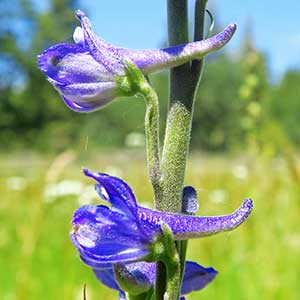Delphinium carolinianum
Delphinium distichum
Carolina larkspur
Burke's larkspur, meadow larkspur, strict larkspur, two-spike larkspur
(20-)40-90(-150) cm;
base reddish or not, ± pubescent.
(25-)30-60(-80) cm;
base sometimes reddish, puberulent.
blade round to pentagonal, 1-8 × 2-12 cm, pubescence variable; ultimate lobes 3-29, width 2-10 mm (basal), 1-7 mm (cauline).
blade cuneate to semicircular, 1-5 × 1.5-7 cm, puberulent; ultimate lobes 5-19, width 2-8(-15) mm (basal), 0.5-3(-5) mm (cauline);
margins of basal leaf, measured less than 1 cm from blade base, demarcating considerably more than 90° of arc when leaf laid flat;
most cauline leaf blades exceeding internodes.
(3-)8-27(-94)-flowered;
pedicel (0.4-)0.7-1.8(-5.7) cm, nearly glabrous to glandular;
bracteoles 1-3.5(-6) mm from flowers, green or blue, linear, 2-7 mm, pubescence nearly glabrous to glandular.
8-30(-40)-flowered, usually dense;
pedicel 0.5-1.5 cm, puberulent;
bracteoles 0-3 mm from flowers, green to blue, linear, 4-8 mm, puberulent.
sepals purple to blue to white, nearly glabrous, lateral sepals spreading, (7-)9-14(-17) × (3-)3.5-6(-8) mm, spurs ± upcurved, ascending 20-90° above vertical, (9-)11-17(-19) mm;
lower petal blades ± covering stamens, 5-7 mm, cleft 2-4 mm;
hairs centered, densest near base of cleft, white, sometimes blue or yellow.
sepals dark blue to bluish purple, puberulent, lateral sepals ± erect, 8-12 × 3.5-5 mm, spurs straight, horizontal or nearly so, 9-15 mm;
lower petal blades ± covering stamens, 4.5-6.5 mm, clefts 2-3 mm;
hairs centered mostly near base of cleft, white.
(10-)12.5-18.5(-27) mm, 4-4.5 times longer than wide, glabrous to puberulent.
7-13 mm, 3.5-4 times longer than wide, ± puberulent.
seed coat cells with surfaces pustulate or smooth.
seed coat cells with surfaces roughened.
= 16.
Delphinium carolinianum
Delphinium distichum
Subspecies 4 (4 in the flora).
(Discussion copyrighted by Flora of North America; reprinted with permission.)
Delphinium distichum hybridizes with D. multiplex and D. nuttallianum (D. ×diversicolor Rydberg). The name D. burkei has often been misapplied to D. distichum.
(Discussion copyrighted by Flora of North America; reprinted with permission.)
1. Basal leaves absent at anthesis, cauline leaves divided into many narrow (less than 2 mm wide) segments, blade not distinctly 3-parted; distalmost petiole less than 5 mm; sepals usually blue or purple (rarely white). | subsp. carolinianum |
1. Basal leaves usually present at anthesis, and/or cauline leaf lobes usually wider than 2 mm, blade often distinctly 3-parted or more; distalmost petiole more than 5 mm; sepals blue or white. | → 2 |
2. Leaf blade distinctly 3-parted with few additional divisions; sepals blue to white; roots usually ± vertical, often without major branches. | subsp. vimineum |
2. Leaf blade with 3–5 or more major divisions, each further divided into segments; sepals white to very pale blue; roots ±horizontal with several major branches. | → 3 |
3. Stems usually less than 45 cm; in thin soils over limestone in clearings of deciduous woods; leaf blade with 3 major divisions; e of Mississippi River. | subsp. calciphilum |
3. Stems usually more than 45 cm; in deeper soils in grasslands; leaf blade with 5 or more major divisions; w of Mississippi River. | subsp. virescens |
- Local floras:
BC,
OR,
WA
- Local Web sites:
Flora NW,
PNW Herbaria
WildflowerSearch
iNaturalist (observations)
USDA Plants Database
- LBJ Wildflower Center
- SEINet
- Plants of the World Online
- Encyclopedia of Life
- Wikipedia
- Google Image Search


